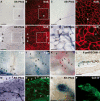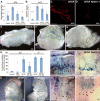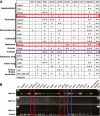Activation of the UNC5B receptor by Netrin-1 inhibits sprouting angiogenesis
- PMID: 17908930
- PMCID: PMC1993874
- DOI: 10.1101/gad.437807
Activation of the UNC5B receptor by Netrin-1 inhibits sprouting angiogenesis
Abstract
Netrins are secreted molecules with roles in axonal growth and angiogenesis. The Netrin receptor UNC5B is required during embryonic development for vascular patterning, suggesting that it may also contribute to postnatal and pathological angiogenesis. Here we show that unc5b is down-regulated in quiescent adult vasculature, but re-expressed during sprouting angiogenesis in matrigel and tumor implants. Stimulation of UNC5B-expressing neovessels with an agonist (Netrin-1) inhibits sprouting angiogenesis. Genetic loss of function of unc5b reduces Netrin-1-mediated angiogenesis inhibition. Expression of UNC5B full-length receptor also triggers endothelial cell repulsion in response to Netrin-1 in vitro, whereas a truncated UNC5B lacking the intracellular signaling domain fails to induce repulsion. These data show that UNC5B activation inhibits sprouting angiogenesis, thus identifying UNC5B as a potential anti-angiogenic target.
Figures








References
-
- Ackerman S.L., Kozak L.P., Przyborski S.A., Rund L.A., Boyer B.B., Knowles B.B., Kozak L.P., Przyborski S.A., Rund L.A., Boyer B.B., Knowles B.B., Przyborski S.A., Rund L.A., Boyer B.B., Knowles B.B., Rund L.A., Boyer B.B., Knowles B.B., Boyer B.B., Knowles B.B., Knowles B.B. The mouse rostral cerebellar malformation gene encodes an UNC-5-like protein. Nature. 1997;386:838–842. - PubMed
-
- Augustin H.G. Tubes, branches, and pillars: The many ways of forming a new vasculature. Circ. Res. 2001;89:645–647. - PubMed
-
- Baluk P., Morikawa S., Haskell A., Mancuso M., McDonald D.M., Morikawa S., Haskell A., Mancuso M., McDonald D.M., Haskell A., Mancuso M., McDonald D.M., Mancuso M., McDonald D.M., McDonald D.M. Abnormalities of basement membrane on blood vessels and endothelial sprouts in tumors. Am. J. Pathol. 2003;163:1801–1815. - PMC - PubMed
-
- Benimetskaya L., Wittenberger T., Stein C.A., Hofmann H.P., Weller C., Lai J.C., Miller P., Gekeler V., Wittenberger T., Stein C.A., Hofmann H.P., Weller C., Lai J.C., Miller P., Gekeler V., Stein C.A., Hofmann H.P., Weller C., Lai J.C., Miller P., Gekeler V., Hofmann H.P., Weller C., Lai J.C., Miller P., Gekeler V., Weller C., Lai J.C., Miller P., Gekeler V., Lai J.C., Miller P., Gekeler V., Miller P., Gekeler V., Gekeler V. Changes in gene expression induced by phosphorothioate oligodeoxynucleotides (including G3139) in PC3 prostate carcinoma cells are recapitulated at least in part by treatment with interferon-β and -γ. Clin. Cancer Res. 2004;10:3678–3688. - PubMed
-
- Carmeliet P., Tessier-Lavigne M., Tessier-Lavigne M. Common mechanisms of nerve and blood vessel wiring. Nature. 2005;436:193–200. - PubMed
Publication types
MeSH terms
Substances
LinkOut - more resources
Full Text Sources
Other Literature Sources
Molecular Biology Databases
